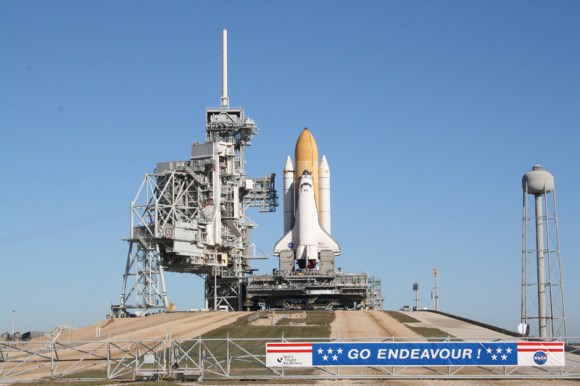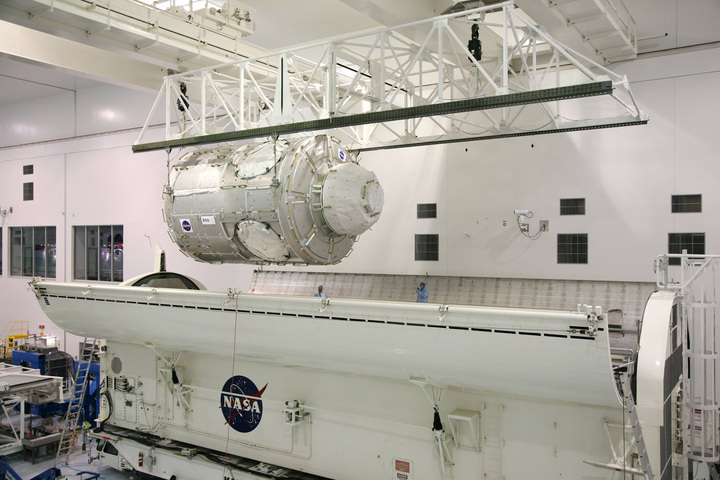Caption: Tranquility and Cupola lowered into canister for transport to Launch Pad 39 A. Credit: NASA
NASA managers decided on Tuesday (Jan. 12) to press forward towards an on time liftoff target date of Feb 7 for Space Shuttle Endeavour as engineers developed a workaround solution to the ammonia coolant hose leak issue which has threatened to delay the launch or seriously alter the mission goals (read my earlier post). The ammonia jumper hoses are critical to the success of the STS 130 mission because they will supply cooling capacity to the new Tranquility module by circulating ammonia and transport the heat generated by the on board systems. Space walking astronauts must connect the hoses from Tranquility to the space station’s cooling system during the STS 130 flight in order to fully activate Tranquility for use by the orbiting outposts crew.
The primary goal of STS 130 is to deliver, attach and activate the Italian built Tranquility pressurized module with will provide significant additional living and work space for the resident ISS crews. Joined to one end of Tranquility is the Cupola observation module. Three EVA’s are planned to accomplish all the essential work to wholly attach and activate Tranquility and also relocate Cupola to an earth facing port on Tranquility.
Mike Suffredini, NASA’s space station manager, decided to proceed toward a Feb 7 launch and that the mission will retain full mission content. Thus there will be no reduction in tasks and NASA is no longer pursuing a “partial” activation of Tranquility. The crew is therefore expected to accomplish 100% of their goals in activating Tranquility and Cupola.
One of the four 14 ft long flight hoses due to be installed by the astronauts failed during the final pre-flight testing on Jan 7 at a subcontractors facility in California. The high pressure hose ruptured during pressure testing at just about half the specified design pressure, at around 1500 psi vs. the specification of approximately 3000 psi.
After a thorough analysis and evaluation, NASA engineering teams decided to select an alternative hose design which involves welding together shorter 7 ft hoses that are already certified and tested for use aboard the station as the primary jumper, according to Pete Hasbrook, NASA’s Expedition 22 lead increment manager. “They have been working on a beefed up version of the hoses, adding a second braid around the hoses, beefing up the weld and the connector that the metal braid is connected to,” Hasbrook explained at a media briefing on Monday (Jan 11). “The new hoses have now been successfully tested to over 3000 psi”.
The new hoses are now under construction and are set to be delivered to the Kennedy Space Center just about one week before the Feb. 7 target launch date. Any further problems could delay the mission as the number of contingency days available for flow processing is declining. There is no longer any consideration of switching this flight with the next mission, STS 131, planned to blast off on March 18.
Tranquility and Cupola were lifted by crane from their workstand (see photos) inside the Space Station Processing facility (SSPF) today (Jan 12) and gently packed inside the nearby payload transportation canister. The current plan is to move them to the pad this Saturday, according to NASA spokesman Allard Beutel. Continuing cold weather at the Kennedy Space Center in Florida has caused a slight delay in pre-launch activities by technicians working to load propellants aboard Endeavour at Launch Pad 39 A. Read my earlier report on rollout of Endeavour to Pad 39 A here.

Caption: Endeavour was rolled out to Pad 39 A on Jan 6, 2010. Credit: Ken Kremer
This entire hose problem stems from NASA’s decision to change the attach location of Tranquility to the port side (left) of the Unity node, designated as Node 1 and located at the center of the station. To accommodate this change in location custom built hoses were required. “The hoses needed to be longer than originally designed”, Beutel explained to me. “Hoses from the group that were set to fly on STS-130 failed so that’s why we’re looking at all the hoses and making modifications to our plans”.
NASA has also decided on a back up “Plan B”, which is to accelerate development of a redesigned set of “functionally equivalent hoses”, at NASA’s Marshall Space Flight Center, based on the design that failed and bring them up along to orbit for use in the event a problem arises with the new primary design.
Meanwhile, the six person crew of Endeavour continues to train at the Johnson Space Center. They still plan to fly to the Cape for several days of countdown dress rehearsal and safety training on Jan 19.
Earlier STS 130 article by Ken Kremer
STS-130 Shuttle flight facing delay due to Payload technical glitch
Shuttle Endeavour Rolled to Pad; Countdown to the Final Five Begins

